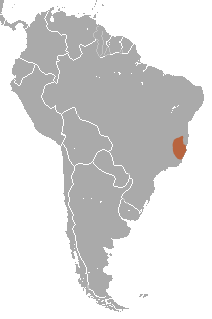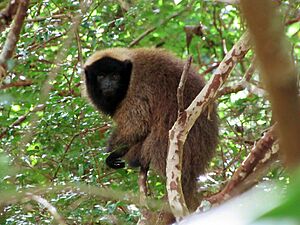Atlantic titi monkey facts for kids
Quick facts for kids Atlantic titi |
|
|---|---|
 |
|
| Atlantic titi in Domingos Martins, Brazil | |
| Conservation status | |
| Scientific classification | |
| Genus: |
Callicebus
|
| Species: |
personatus
|
 |
|
| Atlantic titi range | |
The Atlantic titi monkey or masked titi (Callicebus personatus) is a type of New World monkey. These monkeys are found only in Brazil. They are a special kind of monkey called a titi.
Contents
Where Atlantic Titis Live and What They Look Like
The Atlantic titi belongs to a group of monkeys called Callicebus. There are many different kinds of titis. Some scientists group them differently, but the Atlantic titi stays in the Callicebus group.
There are three main types, or subspecies, of Atlantic titi. Scientists call them C.p. melanochir, C.p. nigrifrons, and C.p. personatus. Some people even think these are separate species! Atlantic titis are medium-sized monkeys. They usually weigh about 1 to 2 kilograms (2 to 4 pounds).
You can find C. personatus mainly in the wet forests of southeastern Brazil. These forests are near the coast and inland. They live in states like Bahia, Espírito Santo, Minas Gerais, Rio de Janeiro, and São Paulo. The Atlantic titi monkey has one of the largest living areas of all titi species. Their home stretches for about 1,000 kilometers (620 miles). They often share their forest homes with other monkeys. These can include lion tamarins and spider monkeys.
How Subspecies Are Different
The three types of Atlantic titi monkeys look a bit different. This is because groups of them got separated over time. Things like rivers can act as barriers. This means the groups can't mix their genes anymore.
The main difference between these titi subspecies is their coat color. This color change is called metachromism. Special cells in their bodies make pigments, or colors. These pigments go into their hair as it grows. This gives their fur its unique color. The Atlantic titi often has dark brown or black pigments. You can see these colors in their eyes, skin, and fur. It's usually on their forehead, head, and tail.
What Atlantic Titis Eat
Atlantic titis are "opportunistic feeders." This means they eat whatever food is easiest to find. Their food choices change with the seasons. They are mostly frugivorous, which means they love to eat fruit. They also eat seeds and leaves.
Why Titis Eat Soil
Sometimes, Atlantic titis eat soil. This is called geophagy. Scientists have a few ideas why they do this:
- They might get extra minerals from the soil.
- It could help balance the acid in their stomachs.
- The soil might soak up bad stuff from the plants they eat.
- They might just like the way it feels in their mouths.
- It could help their digestive system.
- It might help them get rid of internal parasites.
Masked titis are tree monkeys. They almost always stay high up in the rainforest trees. They do this to avoid predators like snakes. They usually stay at least 5 meters (16 feet) above the ground. Because they mostly eat fruit, they rarely go to the ground to look for insects. They prefer to stay in the thick tree branches of the Brazilian rainforest.
When they do eat soil, researchers have seen them eating it from the tops of ant mounds. This is smart for a few reasons:
- It's safer because they can watch for predators. They are also close to the trees for quick escape.
- The soil on ant mounds is easier for them to grab. It's more solid than loose soil on the forest floor.
- There's less leaf litter on ant mounds. This means they spend less time exposed to danger.
For a long time, people thought titis ate soil for salt. Their plant-heavy diet doesn't have much salt. But studies showed the soil they ate wasn't high in salt. The soil did have other minerals. Still, these minerals weren't a huge part of their diet. So, soil isn't a big source of nutrition for them.
Another idea was that soil helped with stomach acid. But recent studies showed the soil they ate was actually quite acidic. So, it probably doesn't help balance their stomach pH.
Scientists also thought the clay in soil might absorb toxins from plants. Clay has a flat shape that's good for this. More research is needed to prove this idea. We don't yet know how many toxins are in the fruit titis eat. Titis also like to eat soil from termite mounds. Both ant and termite mound soil seem to help the monkeys. However, some researchers have noticed that titis often prefer termite mound soil. No one knows why yet.
How Atlantic Titis Survive
Atlantic titi monkeys can live in "disturbed" forests. These are forests that humans have changed or cut down. They will live there as long as there is enough food. They might even prefer these areas if food is more plentiful than in untouched forests. The Atlantic Forest in eastern Brazil has shrunk a lot. Only about 5% of its original size is left. And only a tiny part of that is untouched.
So, the titis' survival depends on living in these changed forests. Titis don't seem to care if a forest is disturbed or not. They just go where the food is. If they can find food, even if humans provide it, they can survive. This is important as many rainforests are being cut down.
Atlantic Titi Reproduction
Atlantic titis are usually monogamous. This means they stay with one partner for their whole lives. They usually have one baby each year. It's hard to tell males and females apart just by looking. But in titi families, the father always carries the baby while it's nursing.
Daily Life of Atlantic Titis
Masked titis have two main ways they spend their day. One way involves two feeding times. These are separated by a long rest. They travel to a different spot for the second feeding. The other way has three feeding times, also with rests in between. In this pattern, they travel more evenly throughout the day. Each feeding time lasts about 2 to 3 hours. Traveling usually takes up about 20% of their day.
Masked titis also "display" their territory every day. They make loud calls to other monkey groups and animals. This tells others to stay out of their area. All titi monkeys also do "Dawn Calls" in the mornings. The male and female usually sing the same song together.



